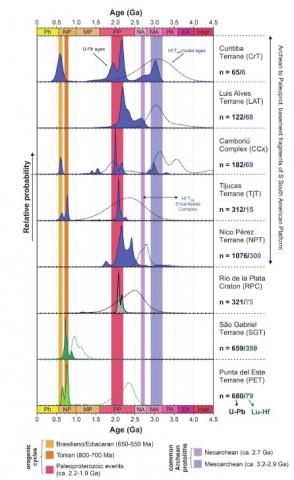Mathias Hueck, Sebastián Oriolo, Miguel A.S. Basei, Pedro Oyhantçabal, Beatrix M. Heller, Klaus Wemmer, Siegfried Siegesmund
2 022
Precambrian Research 369 (2022)
The amalgamation of southwestern Gondwana during the late Neoproterozoic Brasiliano/Pan-African orogenic cycle involved the tectonic interaction of the Congo, Kalahari and Rio de la Plata cratons, together with numerous smaller basement fragments scattered throughout South America. A comprehensive review of U-Pb and Lu-Hf spot analyses in zircon provides new insights on the pre-Brasiliano crustal growth of the main tectonic domains of the southern South American Platform from the Archean to the early Neoproterozoic. The results highlight similarities between five basement fragments, from south to north: the Nico P´erez Terrane, Tijucas Terrane, Camboriú Complex, Luis Alves Terrane and Curitiba Terrane. Whereas these units have variable characteristics, especially concerning differing degrees of tectonic reworking in the late Neoproterozoic, they share similarities in their geological evolution. They were all originally accreted in the Archean, as evidenced by Hf TDM model ages and zircon inheritance, and later experienced intense orogenic reworking during the Rhyacian and Orosirian. The Paleoproterozoic record is diverse and indicates a complex episodic evolution instead of a single orogenic event. Conspicuous diachronic magmatic events took place locally in the Late Paleoproterozoic and Mesoproterozoic, interrupting an otherwise relatively stable tectonic setting until the Neoproterozoic. The Archean origin and strong crustal signatures of the main Paleoproterozoic units distinguish these terranes from the Rio de la Plata Craton, evidencing instead stronger affinities with African crustal blocks such as the Congo and Kalahari cratons. This relationship has implications for the geodynamic reconstruction of southwest Gondwana that extend into the early Neoproterozoic, as it contextualizes the genetic link between the main Tonian events in the region, namely the formation of the S˜ao Gabriel Terrane and the emplacement of the magmatic protoliths of the basement of the Punta del Este Terrane. They can be understood as marginal and within-plate manifestations of an accretionary orogen, respectively. The basement of the Punta del Este Terrane has signatures compatible with the recycling of ancient crust through the mixture of mantellic magmatic input with the partial melting

